TAPAS.network | 16 October 2024 | Commentary | John Dales
It’s like the Wild West on our streets. I can name the outlaws, but where’s the Sheriff?

The streets, kerbsides and pavements of our urban areas are a precious resource that support a varied set of activities contributing to our social, economic and cultural life. Considerate behaviour by all the different users, and strong management by the Highway Authorities are essential elements in making the best of things to everyone’s benefits, believes . But he sees instead a kerbside free-for-all akin to the Wild West, and thinks it’s high time to sort out the outlaws.
THERE’S BEEN an issue nagging at me for my attention in this column for almost two years now, but I’ve found it a tricky one to approach and my thoughts have remained in gestation, awaiting an additional spark of some sort to give them the clarity needed to permit their appearance on these pages. That spark has been provided by some recent domestic news items on a specific theme, which has thrown the wider issues well into the spotlight.
Before I tell you what my 2022 prompt was and my 2024 spark is, let me go back considerably further than two years, to the piece I wrote in February 2019 in LTT766. That article had its genesis in some work I had been doing for the Department for Transport on the topic of ‘Future Streets’, specifically the future kerbside. The point I tried to make then was that – forget about the future – we urgently need, now, to grasp how poorly used and abused the kerbside is today, and to make some basic changes in how we design and manage it if we are to make the best use of new technologies in the years to come.
I wrote then that, “To be frank, the kerbside in most towns and cities is a basket case; a shambles. The real-world use of the kerbside typically bears no relation to what is intended. There are sections laid out for a certain kind of use that are used in other different – and often competing – ways. There are kerbside access ‘controls’ that are routinely misunderstood, wilfully ignored, or simply invisible”.
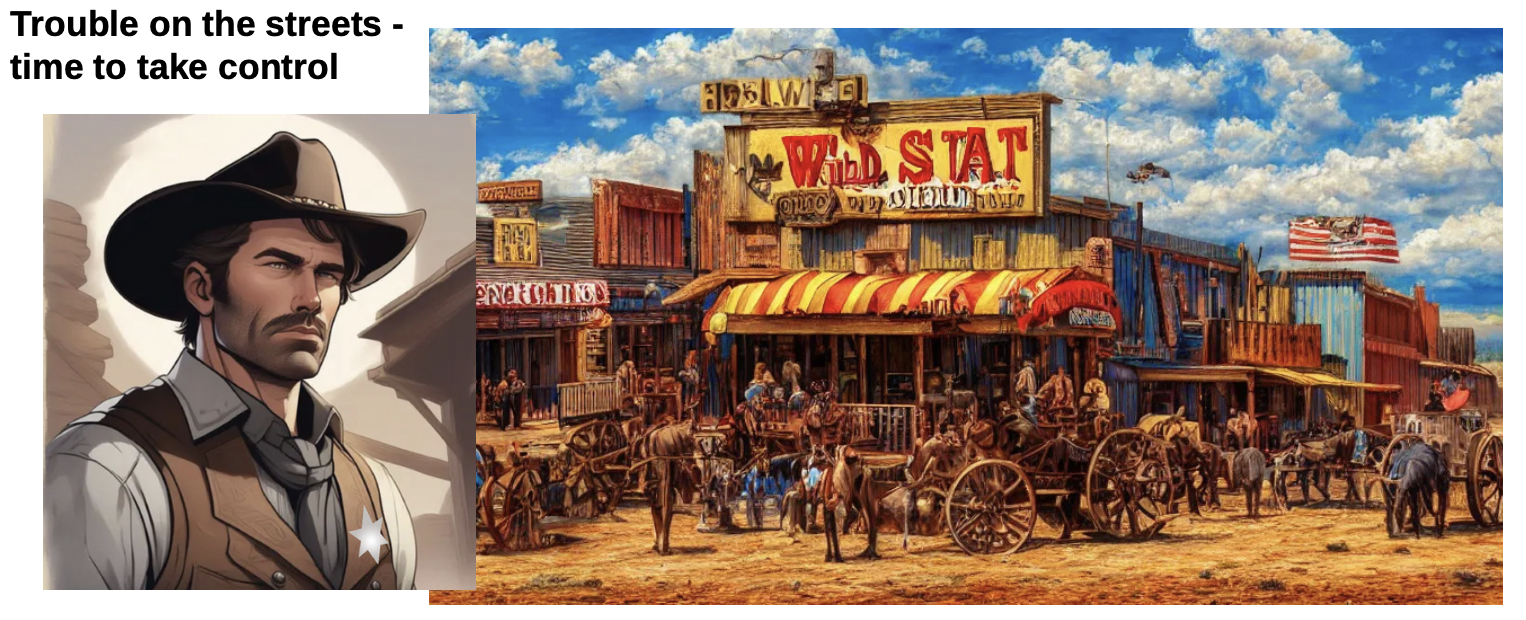
Somewhat over three years later, I revisited the same issue in my piece that appeared in TAPAS (17 October 2022), doing so because I had just completed a commission for the Urban Transport Group that built upon my previous work for the DfT. The fruit of that labour was a report entitled Future Streets: Challenges and Opportunities, which remains available to download from the UTG website: https://www.urbantransportgroup.org/resources/types/report/future-streets-challenges-and-opportunities
My reports for both the DfT and UTG called for local authorities to bring forward Kerbside Strategies and referenced the fact that, in the whole of the UK, only Southwark had one, and even that was only a 2017 draft. Although that has never been published in its final version, we do now have at least two fully-fledged and adopted Kerbside Strategies: Lambeth’s (which I wrote about in TAPAS, 6 February 2023) and Hounslow’s (published this July just gone).
In writing those 2019, 2022 and 2023 pieces (all of which you can still read amongst my collection of articles on TAPAS), my core concern was the same as that raised by the news item I saw in 2022, and now by the more recent UK news items. That concern relates to the gap between what actually happens at the kerbside and what is intended to happen, and how the rapid and continuing growth in forms of commercial activity that exploit the kerbside is turning this gap into a chasm. We intend one thing but get quite another, and my contention is that somehow, soon, we have got to find a way to take back control.
In other words, we need to create a situation in which highway authorities have the powers necessary to exert authority over what happens on the highways they’re responsible for, and the confidence to use them in the overall public interest.
The headline that caught my attention back in 2022 read, “Deliveroo’s sudden collapse in Australia leaves delivery riders scrambling to find new jobs” and the article under it brought back to mind a number of thoughts I had previously had about the negative effects on many urban streets caused by the increasing numbers of food and other delivery riders and drivers working in the gig economy.
The UK headlines that grabbed my attention more recently may not seem directly related to this, but bear with me. They include the following.
“Bristol’s government offices no longer allow e-bikes and e-scooters”
“Investigation: How misinformation on ‘electric bike’ fires is increasing the danger to consumers”
“TIER-Dott pause the long-term rental trial of e-scooters in the West of England”
“E-bike and e-scooters are London’s fastest-growing fire trend”
“Why the e-bike boom is raising fire fears”
“Are Electric Bikes Safe? What Are the Risks?”
The overall impression given by these headlines, and most of the articles beneath them, is that we have a big problem when it comes to the fire safety of electrically-assisted cycles and scooters. And yet, actually, we do not. It is a different and more insidious problem of illegality.
The fire safety problem relates to the small number of e-cycles and e-scooters that have power systems not subject to the standards, checks and controls you’d expect from reputable manufacturers. By which I mean, dodgy conversions from conventional cycles to e-cycles, unregulated e-scooters, and battery charging ‘techniques’ that are unwise, to say the least. And, yes, home-made e-cycles (many of which are not merely e-assisted but entirely e-driven) with unregulated and poorly-maintained batteries, are especially commonplace as vehicles used by food delivery riders.
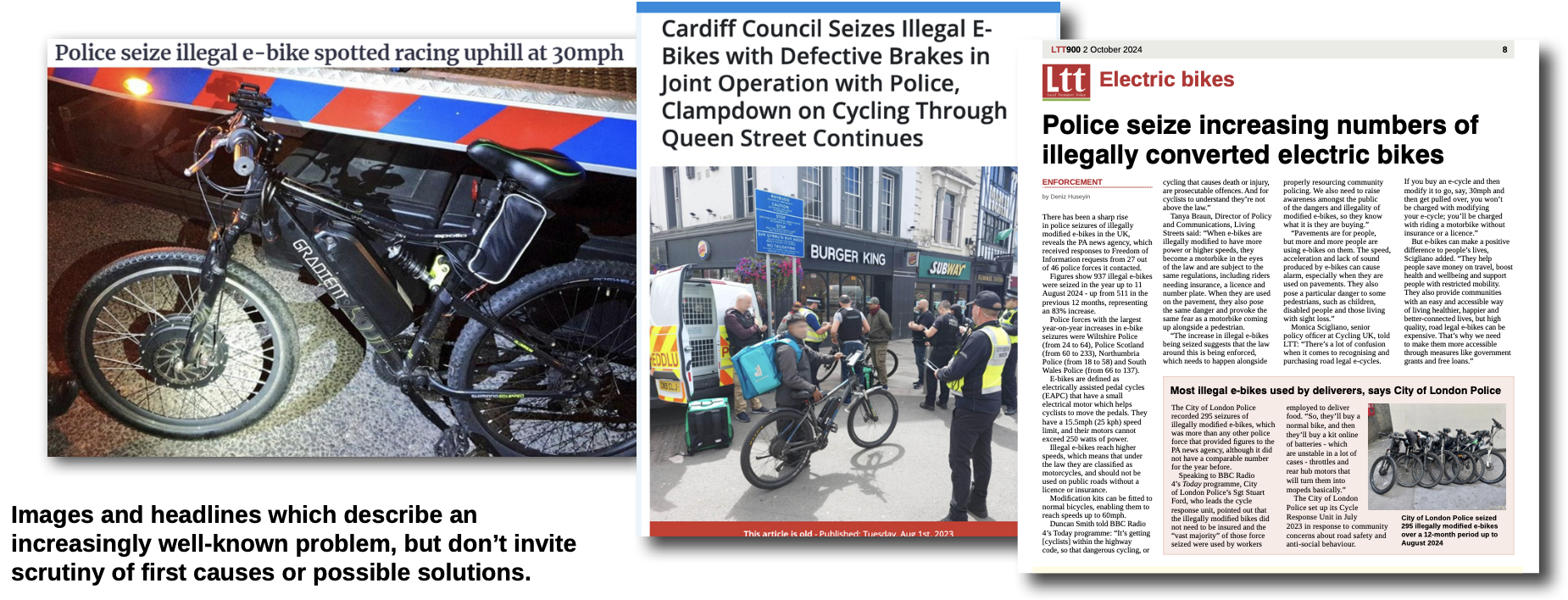
There is real danger that such alarmist headlines and irresponsible reporting, readily jumped on and amplified by folk who – for one reason or another – are against cycling and ‘cyclists’, will threaten the public acceptance and therefore commercial viability of a fledgling e-bike technology that has enormous potential to enable many more people to travel further in a highly space- and fuel-efficient manner. But that’s a topic for another time.
For now, I want to focus on the broader issue of which the use of illegal or unregulated e-cycles by workers in the largely unregulated food delivery industry is just one dimension: the abuse of the kerbside.
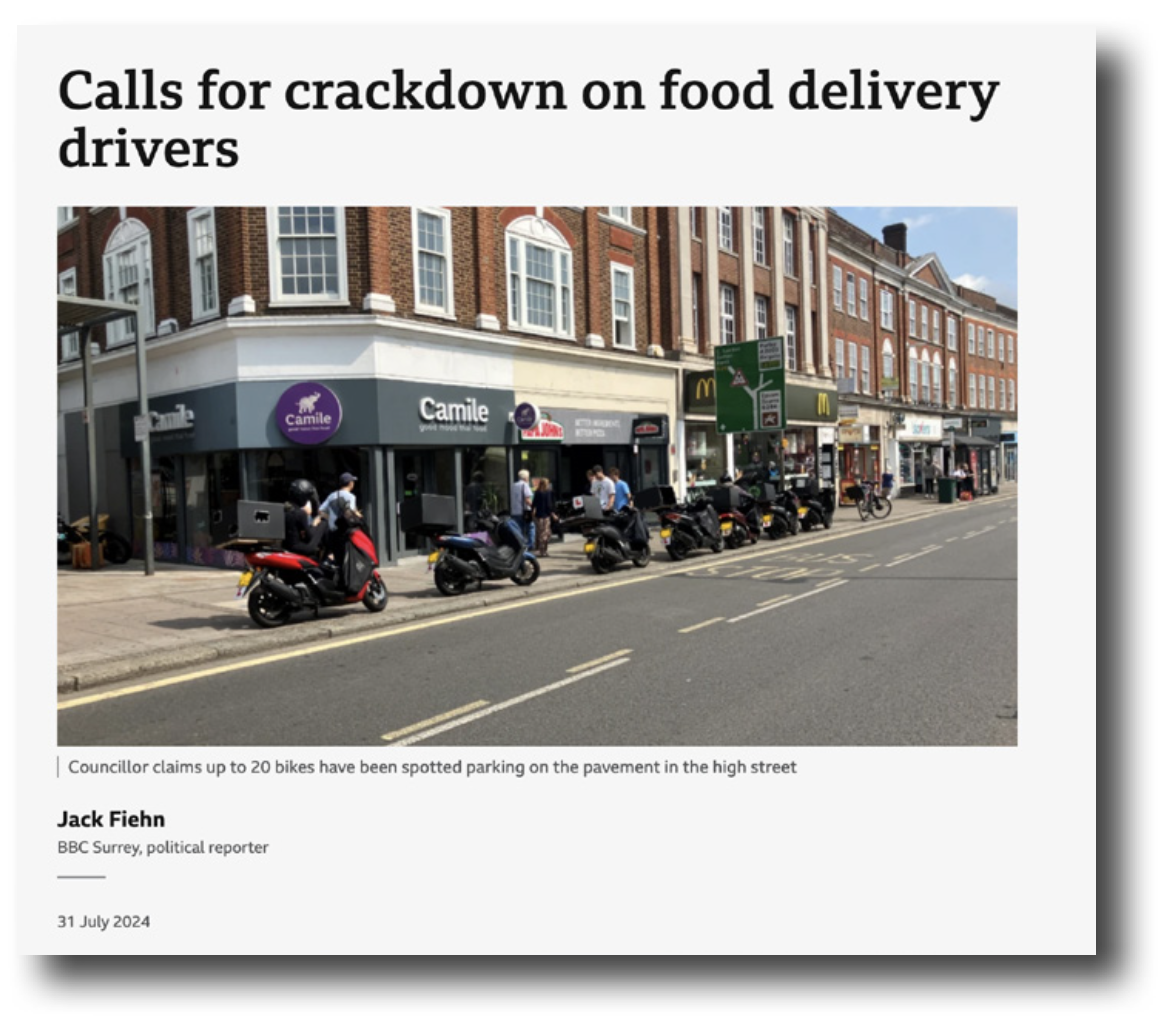
I have no wish to portray the delivery riders themselves as ‘bad guys’ They’re simply trying to earn money from ‘employers’ who couldn’t care less about their welfare or safety. Rather, my purpose is to explore the ways in which the gig economy – or more properly the ultra-free market behaviour of a raft of ‘disruptive’ service sector industries (you may readily conjure up some familiar names here) – is a useful lens through which to view the increasingly routine private exploitation of an extremely valuable public asset: our streets.

A chart which shows how the number of drivers or riders in the gig economy has grown hugely in recent years.
Since re-starting this article, I came upon a just-published report with the intriguing title Dying for Data. Its far less arresting subtitle is “How the gig economy public data deficit conceals £1.9 billion in wage theft, runaway carbon emissions, and a health & safety catastrophe”. All I have space to do here to pass on the following from the executive summary:
“London and other UK cities are lagging far behind their international peers who successfully acquire all journey data from high-volume private hire passenger and food delivery platforms. Other cities use this data to find a fairer compromise between private profit and the public good. Similar access to journey data and algorithmic transparency is essential here in the UK if we are to tackle the mounting external costs of high-volume, high-impact gig economy services. Data shows 38-40% of driver and vehicle time and distance travelled is wasted. This inefficiency in turn has a devastating effect on pay and working hours, the environment and safety on our roads.”
The report concludes that this ‘public data deficit’ conceals the external costs of a dangerously fatigued workforce and the community harms of rampant carbon emissions and urban congestion.
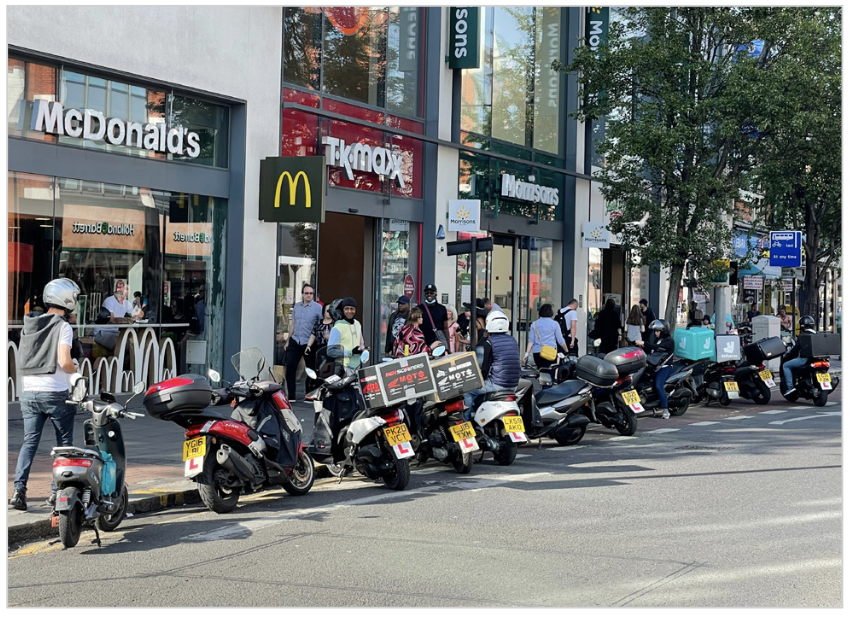
A large group of delivery scooters parked outside a fast food establishment on double-double yellows...
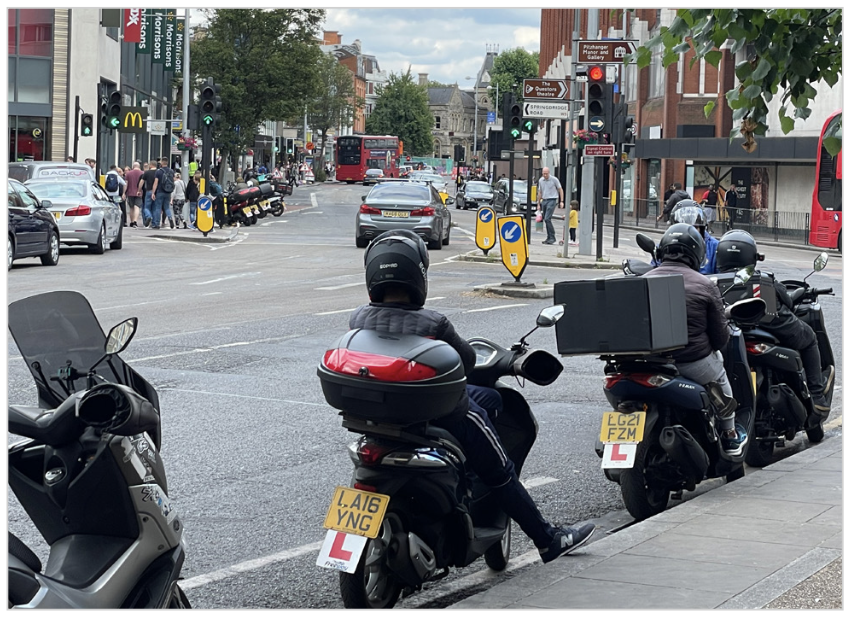
...and the ‘feeder’ rank just across and opposite, also on double-double yellows.
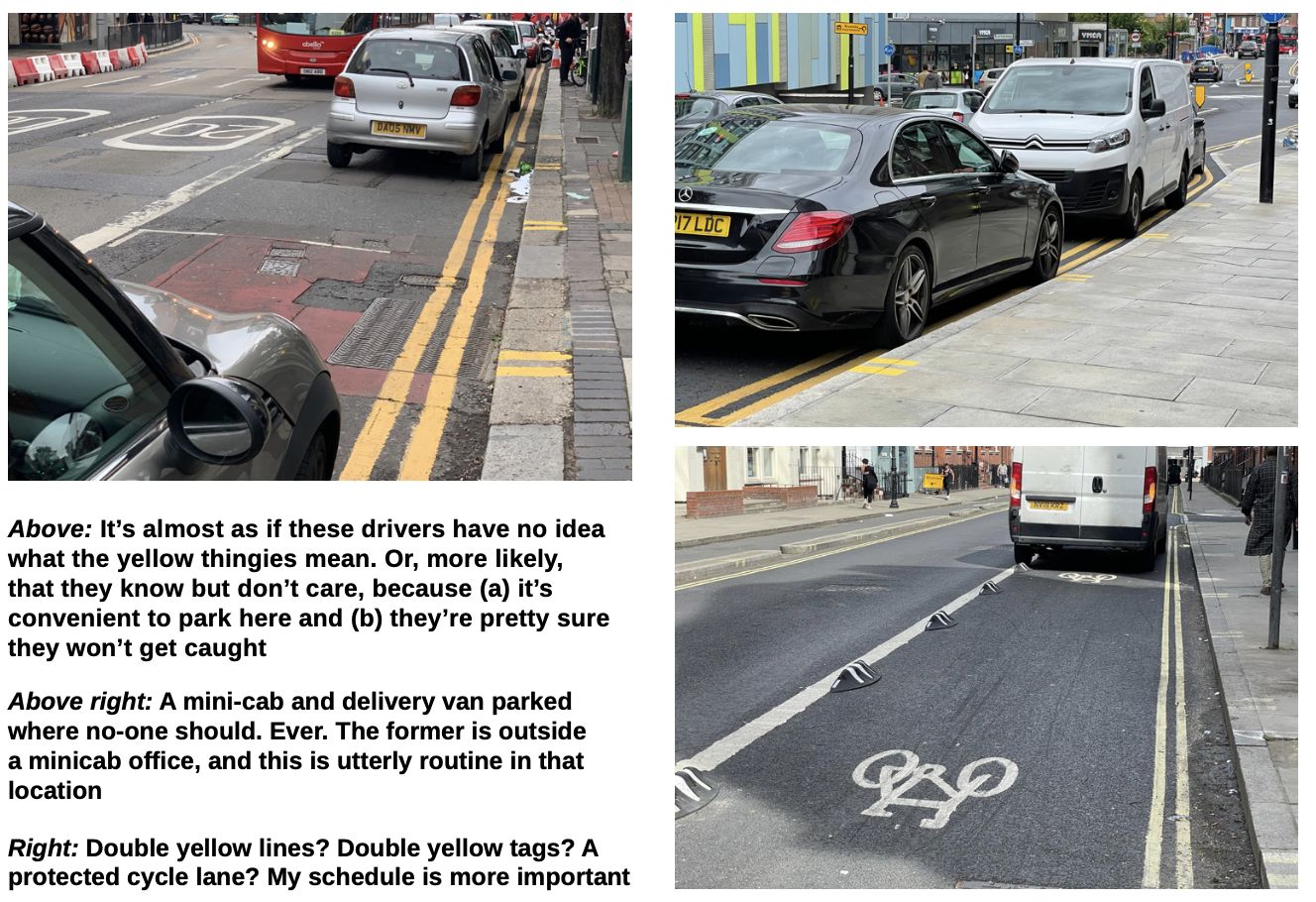
At the kerbside, private profit is currently taking public good to the cleaners, and when I said ‘private exploitation’ above, I meant any use of the public highway where a private company or individual is using a street in ways that may be convenient or profitable to them, but which do not accord with the regulations covering the use of that street at that same time. In essence, then, I’m talking about the use of streets by people who act as though they are ‘above the law’. They may be ignorant of the rules, or in knowledgeable defiance of them, but the effect is the same: that what they want or need to do trumps what the highway authority – the owner of the property in question – intends should happen. And this invariably disadvantages – or hurts – other street users.
Of course, the periodic review of prevailing regulations for relevance, and for possible removal or improvement, is always a good idea. As is checking that they’re properly and clearly advertised, or that they may prohibit reasonable activity or fail to provide for new legitimate needs.
Nevertheless, it’s an undeniable truth that there is persistent contravention of regulations that ought and need to be strictly observed, and other simply outrageous behaviour. Some examples of this are illustrated alongside these words. This behaviour includes parking on the footway where this directly breaks the law (as generally in London and more recently in Edinburgh, and hopefully nationwide very soon) or where it blocks the footway and therefore creates an obstruction. It also includes waiting or loading at the kerbside, for any length of time, in locations where this is prohibited by clearly-marked double yellow lines matched with double yellow blips/tags. Not to mention trading from vehicles or stalls in the most inappropriate locations.
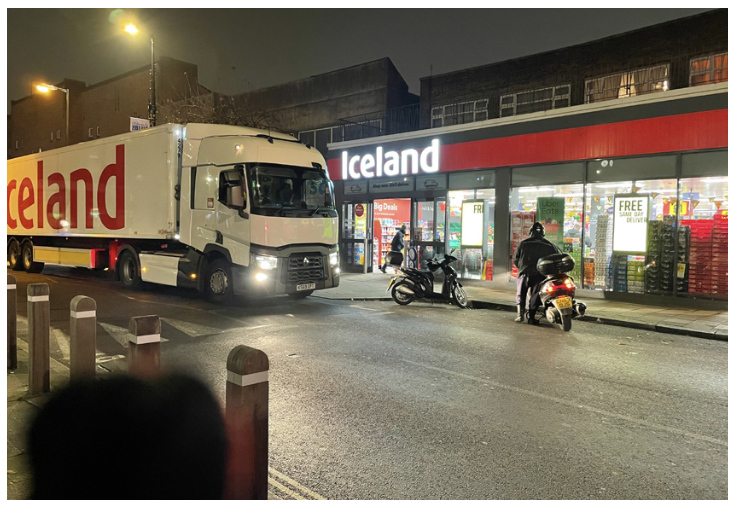
An articulated HGV unable to get into the marked loading bay because of some food delivery scooters. Meaning...
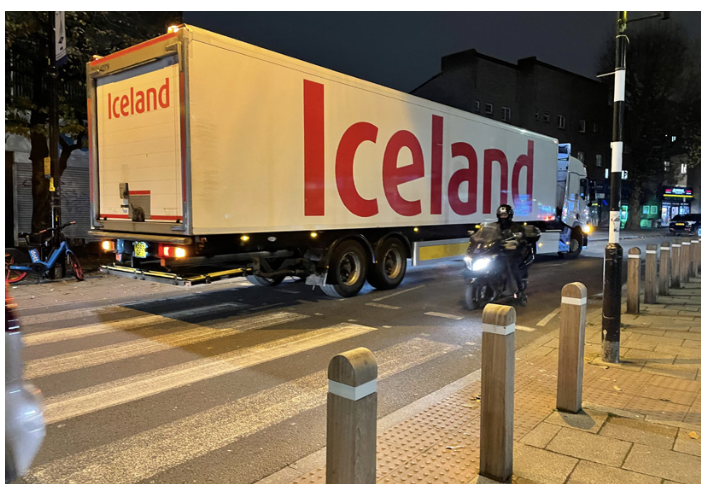
...it was stationary over a zebra crossing for several minutes. But don’t scooters have a right to use that loading bay, too?
That there is far less coverage of this kind of rule-breaking in our various media, than there is about inconsiderately parked dockless shared cycles and scooters, may be due to the same inherent bias that risks demonising e-cycles while e-cars are generally feted. I think, however, that it’s also because the problem with illegally parked motor vehicles is hidden in plain sight as almost ‘normal’, because there’s very little if any sense that the activity is ‘wrong’, and especially because there’s no immediately obvious victim that needs protecting.
What all this gets us to is a highly undesirable status quo in which we have, on the one side, a public sector whose streets are failing to function properly, or fulfil their full potential, and, on the other, a range of private actors, from individuals to ‘disruptor’ enterprises to established businesses with an inadequate social responsibility, who increasingly seem perfectly happy to do whatever seems most advantageous to them.
Part of the problem, perhaps, is that we haven’t yet reached that point where this rogue private activity in the public realm has started to have sufficiently adverse effects on the majority of other private activity, or to be sufficiently visible to decision makers and the influencers of public policy. It has not, in effect, reached a ‘tragedy of the commons’ level, where so many actors are trying to gain advantage by breaking the rules that it affects the ability of everyone else to do so. While that, of course, is arguably a good thing (for the time being), it means that it’s only some of those in the public sector, and specifically in local authorities, who recognise the problem. There is no outcry. Yet.
This, in turn, means that there seems little impetus for change. The lack of outcry, combined with the ever-increasing downward pressure on local authority resources, and the ‘hostile environment’ created by the previous Government in taking any action against ‘motorists’ or ‘drivers’ in particular, has resulted in a situation in which most owners of the public highway appear able to do little more than wring their hands at the fact of their property’s abuse.
I really think this matters. Not least because, if not tackled, familiarity will breed further contempt.
Our streets are far too important to make shrugging one’s shoulders an adequate response to any activity that means their value is diminished. I’ve spoken in these pages before about how we have this hugely valuable public asset that we seem willing just to give away. This should be unacceptable at any time, let alone when the owners of that asset are under financial pressure as never before. Yet, our local authorities have been so cowed by successive Governments, and become so sensitive to claims that they are using traffic- and parking-related fines as a ‘cash cow’, that they’re often almost apologetic about how they manage their property – our property, actually.
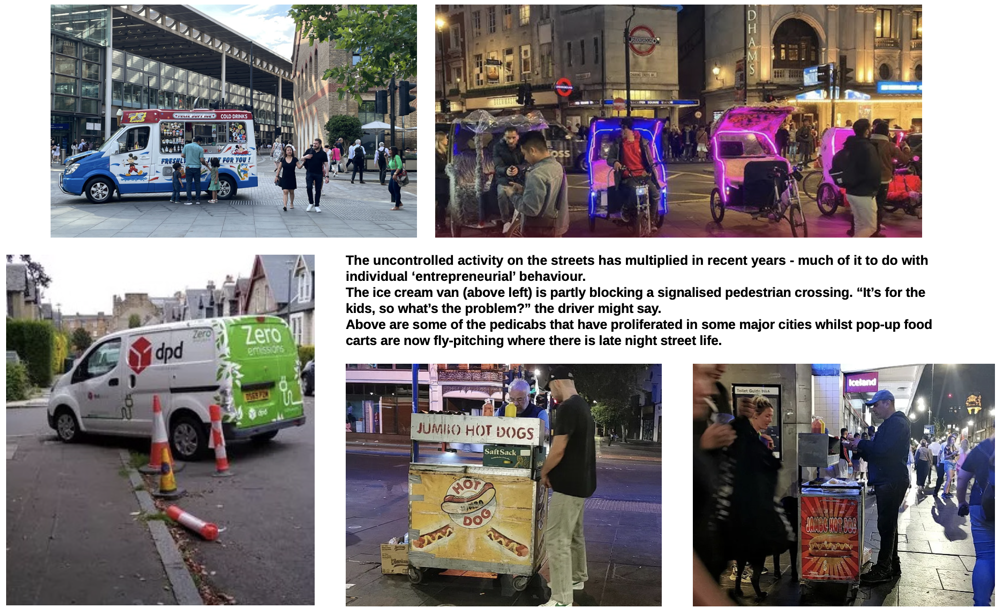
But why shouldn’t the public highway be a source of public income? Especially if the price mechanism helps manage it fairly and efficiently, too.
Local authorities are routinely attacked for using public funds inefficiently. How about public assets?
I acknowledge that this way of thinking will be very hard to present effectively, and gain support for, but we need to try, and the need to do so seems to me to be more pressing with every passing day.
An article entitled Gig Economy Statistics UK, on the StandOut CV website, reveals the huge recent growth in the number of people working in the delivery sector of the gig economy. The percentage of the UK working population estimated to work in the Deliveries/Driving sector of that economy has grown from 1.9% in 2016, to 6.1% in 2019, and to 8.9% in 2021. In 2021, that 8.9% came to an estimate of well over 3.5 million people. Other data, including that in Dying for Data paint the same picture. And, although I know of no relevant datasets, the evidence of our eyes is that growth in the abuse of the kerbside is by no means the sole preserve of the gig economy. We’re all at it!
So, what can we do?
Well, as I said earlier, and with apologies if the phrase triggers any old ‘war wounds’, what should be done is that highway authorities need to take back control. Of their streets. And apply self-funding resources to make things work better, just as they have got used to doing for on street parking. We need some new and smartly structured tariffs for all the ‘commercial’ uses of the kerbside, managed by appropriately resourced teams who can generate income to fund their work. I know for fact that, for example, legitimate delivery companies are willing to pay to ensure their drop offs and pickups are as smooth as possible by having digitally pre-booked ‘slots’.
This task is not just on the local authorities, however. We need both a top-down and bottom-up approach, by which I mean that local authorities will need the proactive support of the national Government. I don’t think we can reasonably expect significant change from somehow appealing to the ‘better nature’ of businesses, disruptors or otherwise, or private individuals. Rather, national and local government need to collaborate in what I call re-marking the playing field.
The field we’re all currently playing on may be level – the same for us all – but it’s not marked out suitably. The rules and regulations should remain the same for all, but they need to be tightened up considerably. A bit like creating the penalty box. How the rules are set, understood, charged for and/or enforced needs to change.
I don’t pretend that this will be easy, but I’m sure it’s necessary. Local authorities need to review, clarify and then confidently apply the rules and regulations applying to the use of the public highway so that they manage and control their streets and kerbsides to ensure public safety and maximise the public value of a public asset. And I’m sure it’s necessary because I’m equally sure that, unless local authorities take the initiative in this way, things will only get worse.
That not just my opinion, it’s a concern raised by a couple of reports published last month by the International Transport Forum (and covered by news items in LTT899). One is entitled The Final Frontier of Urban Logistics: Tackling the Last Metres, and its three key messages are: (i) automated delivery drones and robots may not be effective for last-metre operations in urban areas; (ii) emerging automated last-metre alternatives could exacerbate street-space management tensions; and (iii) transferring last-metre parcel delivery operations to recipients (i.e. getting us to pick our own parcels up for somewhere convenient nearby) can be effective in urban areas.
The other – with a title that’ll never make a snappy acronym – is Lost in Transmission: Communicating for Safe Automated Vehicle Interactions in Cities. It sets out principles and recommendations that the authors consider are required to ensure that AVs receive all the information necessary to achieve the best interactions between them and public space users. In other words, if we don’t properly control the way in which AVs are able to use our streets, then it’ll be bad news for everyone not in one.
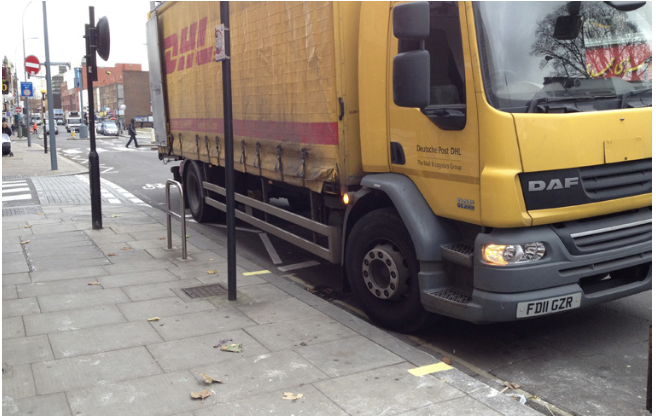
“Zig-zags? Next to a zebra? But the place I’m delivering to is right here. And I’ll only be a minute, (Well, maybe 10.)”
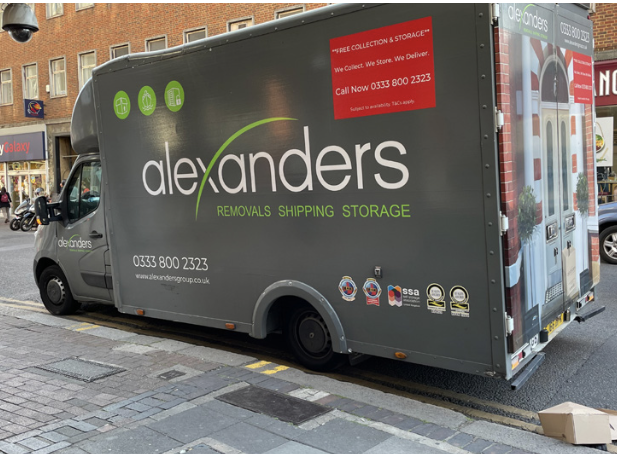
“I couldn’t find anywhere more convenient. Although I may not have tried too hard.”
Given a following wind, I hope to take a deeper look at both these reports next time.
The kind of changes I’m advocating aren’t for local authorities to take on alone. They will, of course, require the active support from the new Government, in a change of direction from their predecessors who actively encouraged kerbside anarchy through rhetoric, policy-making and law-making that enabled individuals, indeed almost encouraged them, to believe that most controls on their driving and parking wishes are unreasonable.
Suitable regulatory action might also come in the context of Labour’s pledges to tackle the gig economy. By avoiding their responsibilities to their ‘employees’, the companies behind this economy have, in my view, helped undermine the rules of the playing field. By encouraging, but then turning a blind eye to, illegal activity by ‘their’ drivers and riders (‘Nothing to do with us’), they have not only helped turn the kerbside into a (literally) free-for-all, they have also endangered the drivers and riders involved.
Commenting on research into the gig economy by University College London, published in 2022, the Parliamentary Advisory Council for Transport Safety (PACTS) said, “It confirms what many people have suspected; that companies are exploiting their delivery gig-workers, risking their safety and the safety of other road users for profit. It is high time that the Government and Health and Safety Executive stepped in to prevent these dangerous practices”. Dying for Data makes a similar case.
With a less hostile Government to deal with, this is surely the best time for years for local authorities collectively to develop and take the case for change to Westminster. Because this isn’t just a niche issue about some bad faith actors abusing regulations that no-one likes anyway. It is, in my view, about both re-building the sovereignty of local authorities, and enabling them properly and reasonably to monetise their most valuable asset in the best interests of the wider community.
Streets for the People! Now there’s a slogan that ought surely to suit a Labour government.
References and Links
-
Gig Economy Statistics UK, on the StandOut CV website
-
Several previous John Dales and Phil Goodwin articles on TAPAS:
-
The Final Frontier of Urban Logistics: Tackling the Last Metres. International Transport Forum.
John Dales is a streets design adviser to local authorities around the UK, a member of several design review panels, and one of the London Mayor’s Design Advocates. He’s a past chair of the Transport Planning Society, a former trustee of Living Streets, and a committee member of the Parliamentary Advisory Council for Transport Safety. He is director of transport planning and street design consultancy Urban Movement.
This article was first published in LTTmagazine, LTT901, 16 October 2024.
You are currently viewing this page as TAPAS Taster user.
To read and make comments on this article you need to register for free as TAPAS Select user and log in.

Log in